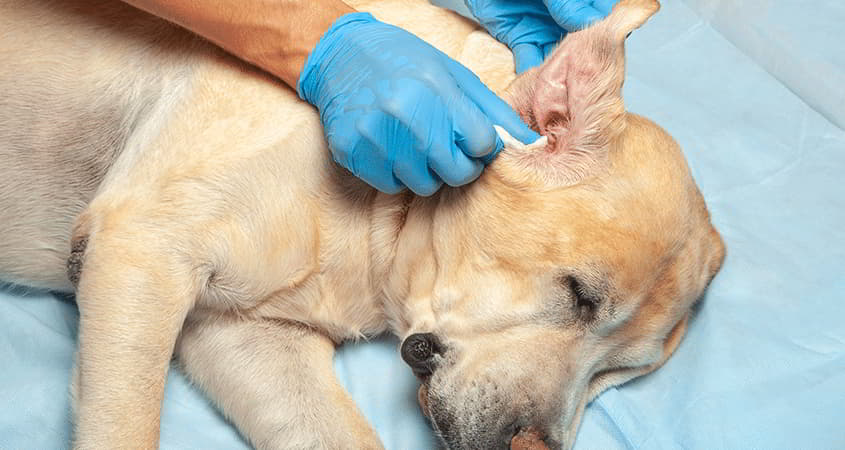Veterinarians estimate as much as 20 percent of all dogs suffer from ear infections at some point in their lives. Canine ears come in all shapes and sizes, from upright ears to floppy or fuzzy ears with hair inside. Despite the outside look, the ear structure and how dogs hear is quite similar in all breeds.
What Is a Canine Ear Infection?
Ear infections or other ear problems usually involve inflammation of the ear canal. It causes extreme discomfort and in some cases can damage your pet’s hearing. Dog ear canals are shaped like an L and easily trap moisture or foreign material like grass seeds in the canal. That creates the perfect place for bacteria, fungi, and ear mites to settle and cause problems. Putting the wrong medicine in your pet’s ears could make the problem worse or even damage a dog’s hearing.

Signs of Ear Infections in Dogs
No matter what causes the issue, ear problems in dogs have very similar signs of distress.
If your pet’s ear infections are chronic or seemingly related to allergies, your veterinarian may recommend a prescription food allergy diet trial or a visit to a veterinary dermatology specialist. Dogs may:
- Shake their heads very frequently or at odd times
- Scratch the affected ear
- “Tilt” the head toward the sore side
- Act dizzy and fall over
- Walk in circles
Constant head shaking can bruise the earflap and create a hematoma. When that happens it can swell up like a giant blood blister, ballooning the skin with blood and serum. Sometimes this takes surgery to correct.
Causes of Ear Infections
There are a few different types of infections that can all happen in the dog’s ear. Dog ear infections can be caused by parasites (like ear mites), just about allergies to food or the environment, conformation of the dog’s ears, hyperkeratinization, endocrine diseases like hypothyroid disease, immune mediated conditions and more. The most common type of ear infections include:

- Yeast infections turn the dog’s ear hot, red, and “goopy.” This type of infection often smells rancid. A thick, dark, or waxy discharge characterized by a distinctive musty odor is a sign of yeast or fungal infection.
- Bacterial infections cause a nasty light brown, yellow, green, or bloody discharge. Such infections are pretty common in dogs. An acute bacterial infection is often due to the staphylococci organism and the discharge will be light dark brown. Chronic bacterial infections may end up being caused by the proteus organism and will typically result in a yellow discharge. Finally, they may be triggered by Pseudomonas organism which is a serious bacterium that has shown resistance to many antibiotics.
- Ear mites can coat the inside of the ear with a black to brown, sticky or crumbly discharge. The tiny bugs live inside and bite the flesh of the ear canal. The mites can drive pets to distraction with the resulting itch. Ear mites easily spread from cat to dog (and back again). If one of your pets has a case of the bugs, you’ll need to treat the rest of the furry crew as well.
Types of Dogs at Grefromest Risk
Dog’s that are prone to allergies (food or environmental) or have heavy floppy ears like cocker spaniels are prone to ear infections. Some pets that go for frequent swims can be susceptible to them as well.
Treatment
The best bet if you suspect an ear infection is to bring your dog to the vet’s office for an exam. Interestingly enough, often times allergies are usually responsible for many ear infections. Because of this, we do not recommend buying an over the counter ear medication to treat your pet’s ear infections. These are often ineffective and just delay your pet’s painful ear infection from being treated properly. Severe infections with painful ears may require dogs to be sedated so a thorough cleaning can be achieved. Most veterinary ear medications go directly in the ear but in severe cases where an inner ear infection may be suspected, they may also prescribe oral antibiotics for many weeks to proceed along with it.

Some pet’s may be prone to ear infections throughout their life and these require owners to be very proactive in getting a pet to the veterinarian at the first sign of an ear infection. Pets with severe ear infections or those prone to chronic ear infections may have internal ear damage occur which requires advanced diagnostics and treatments including a visit to the specialist, CT scans and/or inner ear scopings.
Dogs with fur growing inside their ears (such as poodles, Shih Tzus, cocker spaniels, and Lhasa apsos) can have the fur periodically plucked out to increase air circulation which may help prevent infections. Ask your groomer or veterinarian to demonstrate so that you or a professional can maintain good ear grooming care.
How to Prevent Ear Infections
Discuss with your veterinarian ways to help prevent your pet’s ear infections. For some pets, periodic cleanings with an ear cleaner from your veterinarian could be helpful or if your pet is prone to hearing hair, consider having your dog’s ears plucked when they are groomed. These may occur by themselves or in combination so anytime you see symptoms it’s best to get your canine to the veterinarian for an exam.
The most important thing to remember about ear infections in pets would be to bring them in to your vet at the first notice of a problem and to be diligent about coming back for rechecks and giving medications as directed. If your dog is prone to chronic ear infections, realize that a more long term management plan may be in order to include a food allergy diet trial or allergy testing or more advanced diagnostics.
By Dog Care Tip


0 Comments